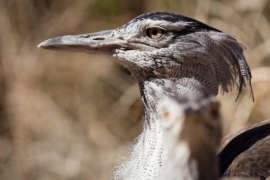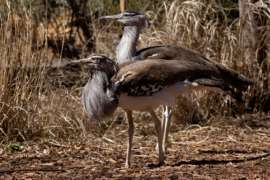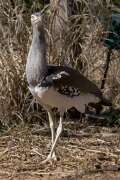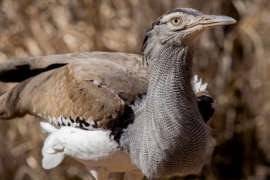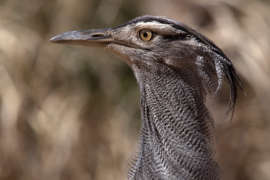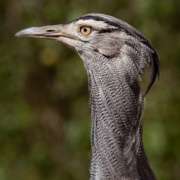Kori Bustard
Kori Bustard
Kori bustards are very large, ground-dwelling birds that that eat a variety of insects, small animals and some plants. The males are among the heaviest of all flying birds. Recent threats from large-scale agriculture and the bushmeat trade have resulted in sudden declines in this species.
Ardeotis kori
Omnivore
Eastern Africa, Southern Africa [VIEW MAP]
Grasslands, Woodlands
Kori bustards are robust birds and thrive in most of Atlanta’s seasonal conditions. However, on the coldest or rainiest days, they may choose to be in their covered shelters and may not be as visible. If you are lucky, you will see and hear the amazing breeding postures and vocalizations from the male. If you hear a slowly repeated, deep booming vocalization while on the north side of the Zoo, be sure to go check the kori bustard habitat to see if the male is responsible. If so, he will be standing still, with his throat enormously inflated with feathers puffed out in every direction, and uttering one of the most amazing of all natural sounds—quite a sensory thrill for our lucky guests!
Photos and Videos
The giant males of this species are among the heaviest of all flighted birds. The species exists in two separate areas of Africa, and those populations in eastern Africa and southern Africa are so distant from one another that it is not likely they would interbreed. Rarely flying, and never migrating, these birds stalk the savannas looking for any large insect or small animal to eat and will also consume fruits, flowers, as well as dig up roots of specific nutritive plants.
This is the largest species of bustard, a group of generally large Old World ground-dwelling birds. Male kori bustards are among the heaviest birds capable of flight, sometimes weighing in at around 40 pounds. Unlike other heavy birds, such as swans, they do not fly over long distances. Males are much larger than females, which are about 15 pounds.
Most bird species have a specialized gland at the base of the tail that produces an oily secretion that they collect with their bills and then spread across their feathers while preening. This secretion is used to protect and water-proof the feathers. Bustard species are a bit unusual among birds in that they lack this organ. Nevertheless, like all birds, kori bustards are fastidious in preening themselves to keep all the feather barbs in order, remove old feathers, and remove parasites. In terms of cleanliness, bustards and other birds lacking this specialized gland, such as pigeons, take dust baths regularly and use a coating of dust to protect their feathers.
These birds do not form long-term pair bonds. The males attract the females with their deep booming calls, and they show off their plumage to full effect during elaborate courtship displays known as leks. A lek breeding system, common in many bird species, involves the males gathering in a specific area and simultaneously displaying their courtship behaviors and vocalizations. In the case of kori bustards, the area of the lek is large because males maintain and defend territories of considerable size. The males render their physical displays and vocalizations simultaneously while females enter the area, assess the various males, and make their choice.
Females lay two eggs and are completely responsible for incubation and rearing of chicks. A kori bustard nest is a very simple affair, being just a scrape on the ground, onto which the female lays one or two eggs. Chicks take five years to mature, and adults may live more than 30 years. The populations in eastern Africa breed at different times of year, cueing in on the differing climates of the regions. The species does not move over long distances and is non-migratory, which helps explain the relative distinctness of the two isolated populated regions in Africa. In the face of potential predators and, especially, in defense of their nests, these birds will present an impressive display of puffed feathers, exaggerated movements, bill snapping, and vocalizations.
Kori bustards are robust birds and thrive in most of Atlanta’s seasonal conditions. However, on the coldest or rainiest days, they may choose to be in their covered shelters and may not be as visible. If you are lucky, you will see and hear the amazing breeding postures and vocalizations from the male. If you hear a slowly repeated, deep booming vocalization while on the north side of the Zoo, be sure to go check the kori bustard habitat to see if the male is responsible. If so, he will be standing still, with his throat enormously inflated with feathers puffed out in every direction, and uttering one of the most amazing of all natural sounds—quite a sensory thrill for our lucky guests!
The range of the kori bustard is discontinuous, with populations in eastern Africa and separate populations in southern Africa.
This species is most commonly found in tall grasslands of the African savannas or in similar conditions in sparse woodlands. They are tolerant to traditional-scale human agricultural activities such as subsistence wheat-farming and do not threaten crops in any serious manner. Despite their large size, they are very cryptic in their natural environment. This allows them to stealthily seek small animals as prey and elude the famous large predatory mammals that share their same habitat.
Kori bustards eat nearly anything they can find, including larger insects such as locusts and dung beetles, as well as vertebrates such as other birds, lizards or small mammals. They will consume carrion when they find it, and actively seek out a variety of fruits, seeds and flowers and will dig up roots of specific nutritive plants. At the Zoo, they are offered a varied diet of mice, raw meat, crickets and fruits.
Zoo Atlanta is an active participant in the Kori Bustard SSP, and we collect shed feathers that otherwise would be discarded so that their beauty may be enjoyed by recreational anglers and fly-tying hobbyists.

